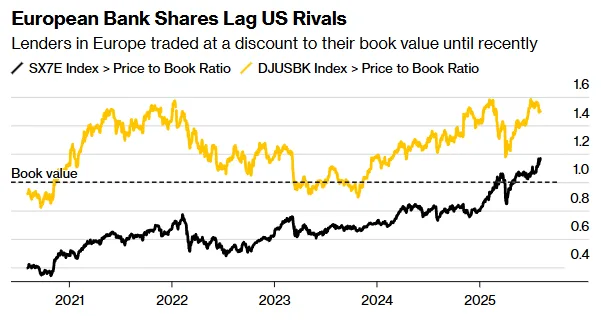- North American banks are requiring an average of 4.2 days in-office per week, compared to 3.4 days in Europe, highlighting a growing divergence in return-to-office (RTO) policies.
- While US executives like Jamie Dimon push for full-time office attendance, European leaders such as Bill Winters emphasize flexibility and employee autonomy.
- The transatlantic RTO gap is shaped by differing labor regulations, market performance, and talent retention strategies—raising questions about productivity, culture, and long-term outcomes.
Two Worlds, Two Cultures
Five years after the onset of COVID-19, return-to-office mandates have become a key fault line between US and European banks, reports Bloomberg. A recent analysis shows that 11 of North America’s 15 most valuable banks require four or more days in-office each week. In contrast, only seven of Europe’s top 15 banks meet that threshold—and none demand five full days.
North American banks are averaging 4.2 days/week of required in-office time for some or all staff. In Europe, the figure sits at 3.4 days, with many banks preserving hybrid arrangements to compete for talent.
The Leadership Divide
Few figures illustrate the contrast more starkly than Jamie Dimon, CEO of JPMorgan Chase, and Bill Winters, CEO of Standard Chartered. Dimon has insisted on a five-day in-office schedule, brushing off employee pushback, while Winters has embraced a more flexible approach, emphasizing trust and self-management.
“It’s their way or the highway,” said Mike Mayo, a veteran banking analyst at Wells Fargo, referring to Wall Street’s more rigid stance. He sees office mandates as signaling ambition and drive.
But not all US banks are aligned. Citigroup, amid a deep restructuring, is sticking to three days in-office, with added flexibility such as two bonus weeks of remote work in August.
Get Smarter about what matters in CRE
Stay ahead of trends in commercial real estate with CRE Daily – the free newsletter delivering everything you need to start your day in just 5-minutes
Europe’s Flexible Strategy
Top European lenders like BBVA and Intesa Sanpaolo continue to view remote work as a recruitment and retention tool. BBVA, for example, supports two days of remote work per week, calling it key to attracting talent.
Meanwhile, broader shifts—such as London’s moves to promote commercial-to-residential space conversions—also suggest a more flexible, long-term approach to workplace strategy in Europe.

Labor laws are another limiting factor. Societe Generale’s move to standardize remote work across regions won’t fully take effect in France until 2026, while Deutsche Bank and Bank of Ireland have faced resistance from unions over even modest increases in required office time.
Does RTO Drive Results?
While some argue that in-person work fosters culture and performance, academic evidence is mixed. A University of Pittsburgh study published in 2024 found no improvement in financial performance after RTO mandates—but did find a significant drop in employee satisfaction.
The study also linked RTO pushes to weaker stock market performance, suggesting that mandates may stem more from managerial control than strategy.
What’s Next?
As Asian banks adopt varied models—from Japan’s hybrid approach to China’s full return—the global workplace landscape remains fluid.
Still, the US–Europe divide is likely to persist. Bonnie Dowling, partner at McKinsey, expects the gap to remain, particularly as cities like London incentivize alternative uses for office space.
For now, the debate continues: control vs. flexibility, performance vs. morale, short-term visibility vs. long-term talent retention.
Why It Matters
The transatlantic divide in return-to-office mandates signals deeper differences in culture, regulation, and competitive strategy. As banks seek to balance efficiency and employee engagement, their choices could influence not only talent attraction—but the future of global finance itself.

















